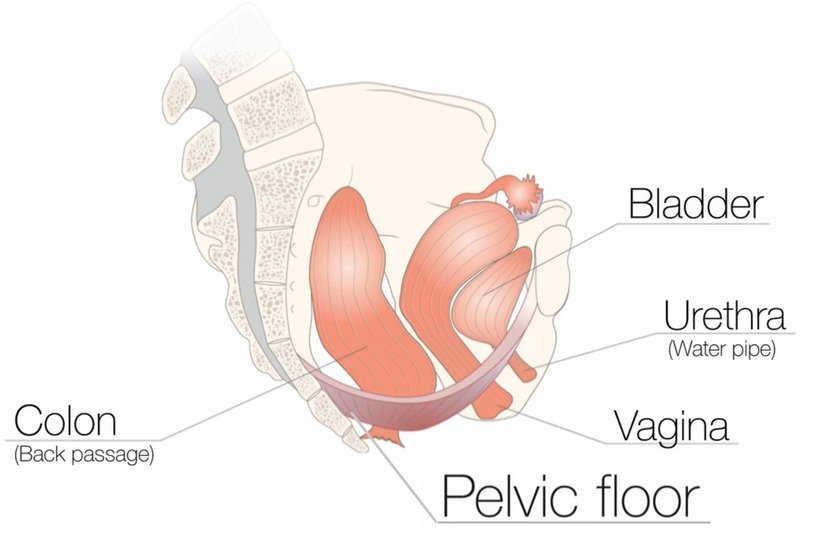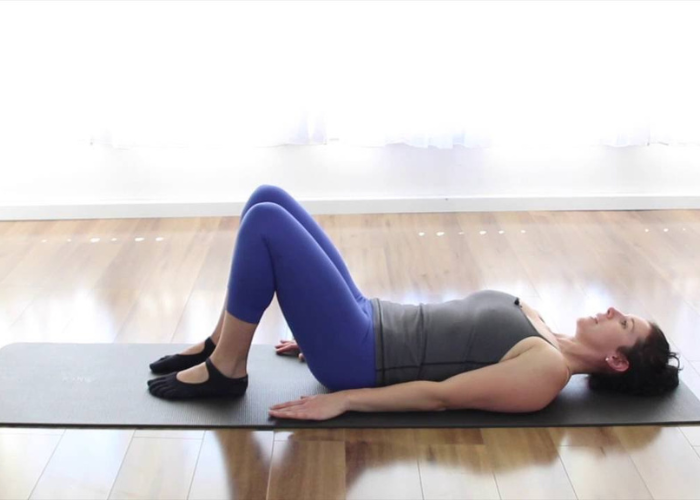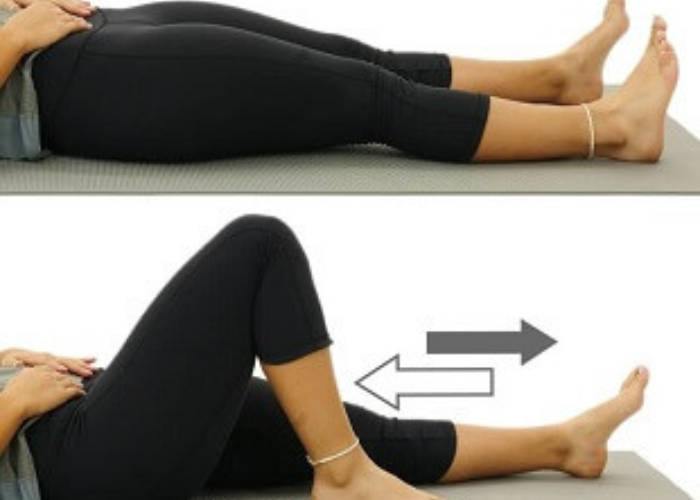What it is | Function | Gender specifics | Finding your pelvic floor | Dysfunction | Too tight vs. too lax | Benefits of strengthening Exercises | When to get help | Bottom line
If you can’t sneeze, laugh, or cough without leaking a little urine, you’re not alone. Problems with the pelvic floor are common and can happen to anyone.
The good news? Incorporating specific exercises (aka pelvic floor muscle training) into your overall fitness routine can help strengthen your pelvic floor muscles, as well as reduce the severity of symptoms of pelvic organ prolapse.
Here’s an easy-to-understand guide to what the pelvic floor is, what it does, how to find these muscles, and tips regarding when to see a professional. Plus, it provides five exercises to help strengthen your pelvic floor that you can start doing right away!
What is the pelvic floor?

The pelvic floor comprises muscles and connective tissues. These soft tissues attach to your pelvis, and more specifically, to the bones at the bottom of the pelvis.
In all people, the pelvic organs include the urethra, bladder, intestines, and rectum. If you have a vagina, the pelvic floor also consists of the uterus, cervix, and vagina (3).
A good way to visualize the pelvic floor and its function, says Marcy Crouch, PT, DPT, WCS, a board certified clinical specialist in women’s health, is to picture these muscles at the bottom of the pelvis like a hammock or basket.
“When the pelvic floor is engaged or contracted, it performs a lifting motion toward your head, which feels like you are trying to stop gas or urine, or pucker your anal opening,” she says.
SUMMARY
The pelvic floor comprises muscles and connective tissues that attach to the pelvis.
What does the pelvic floor do?
The pelvic floor muscles are critical to daily functions. They support the pelvic organs, including the bladder, urethra, rectum, anus, prostate, uterus, cervix, vagina, and intestines (4).
Pelvic floor muscles also contribute to sexual health and function, including arousal and orgasm (5, 6).
Plus, they help stabilize your hips and trunk, especially when walking and standing.
Pregnancy and vaginal birth can weaken these muscles, causing a host of issues, which range in severity from mild pain and discomfort to pelvic organ prolapse (7, 8).
But it’s not just pregnancy or childbirth that can cause pelvic floor dysfunction. It can also occur with age, menopause, surgery, repeated heavy lifting, prolonged sitting, sexual abuse, or conditions that create pressure on the abdomen, such as excessive weight.
Additionally, certain habits, symptoms, or conditions can contribute to pelvic floor disorders, such as endometriosis, irritable bowel syndrome, interstitial cystitis, and habitual patterns of avoiding or restricting bowel movements (4).
SUMMARY
Pelvic floor muscles support the urethra, bladder, intestines, rectum, and other pelvic organs. If you have a uterus, cervix, and vagina, the pelvic floor also supports these organs.
Do people of all genders have these muscles?
For a lot of people, the concepts of Kegels and the pelvic floor are synonymous with a vagina, and more specifically, pregnancy.
But what you might not know is that people of all genders have these muscles. In people with a penis, the pelvic floor muscles support the bladder and bowel, preventing leakage of stool and urine (9).
They also help with sexual health, including function and sensation.
Common diagnoses of pelvic floor disorders in men include chronic prostatitis, pudendal neuralgia, genitofemoral neuralgia, and hypertonicity (10).
SUMMARY
People of all genders have pelvic floor muscles.
How do you find the pelvic floor muscles?
One of the simplest ways to find the pelvic floor is to stop or slow urine flow while going to the bathroom. If you can do this successfully at least a few times, you’ve found your pelvic floor.
Another good way to activate the pelvic floor muscles, says Crouch, is this:
- Lie down with your knees bent and feet flat on the floor. Inhale.
- Exhale gently, draw in your lower abdominal muscles, and squeeze in the muscles around the urethra like you’re trying to stop gas or urine. People with a vagina can also focus on lifting or squeezing the muscles around the vagina.
- Hold for 1–2 seconds, then let everything go. You should feel the pelvic floor muscles release and drop.
One way to find the pelvic floor muscles while standing is to imagine you need to pass gas but don’t want to let it out.
If you’re trying to hold it in, there’s a good chance you’ll squeeze your rectum and anus. The muscles you activate are those comprising the pelvic floor, especially if you feel a pulling sensation at your anus.
When engaging the pelvic floor, it’s important to remember that these muscles span the distance across the bottom of your pelvis. So, if you’re contracting only the muscles that control the flow of urine but not the rectal muscles, you aren’t getting a full contraction.
For the most effective contraction, engage both areas — the muscles that would stop gas and urine simultaneously. Research has also shown that engaging the transversus abdominis and obliques at the same time may help deepen pelvic floor muscle engagement (11).
Likewise, engaging the pelvic floor muscles may contribute to a stronger abdominal contraction (12).
This is especially important to remember when you’re an active individual or looking to increase your core strength for functional purposes.
Still, learning to release or relax the contraction of these muscles is just as important for optimal pelvic floor function. Once you’re able to feel the sensation of contraction in these muscles, check in with yourself occasionally: Are these muscles always turned on, even just a little?
One way to think about it is to imagine your pelvic floor muscles as an elevator. When you’re sitting at your desk or standing and doing dishes, take note of where the elevator has come to a stop. Is it at the bottom floor? At the third floor? Or all the way at the tenth?
Learning to let the elevator rest at the bottom is important, too, as excess tension in these muscles can cause pain.
SUMMARY
There are several ways to find the pelvic floor muscles, including stopping urine midstream and trying to prevent gas from leaving your body. It’s important to learn how to both contract and relax these muscles.
What is pelvic floor dysfunction, and how common is it?
When the pelvic floor muscles are weak or malfunctioning, they lose the ability to fully support the pelvic organs, causing pelvic floor disorders.
These disorders can include urinary or fecal incontinence, urgency urinary incontinence, overactive bladder, and pelvic organ prolapse, and they might cause symptoms like painful sex (13, 14).
It’s hard to estimate how many people have a pelvic floor disorder, as awareness of the symptoms and conditions remains low. Many people who identify as women assume pelvic floor dysfunction is a normal part of childbirth or aging and therefore don’t seek treatment.
However, it’s estimated that about 1 in 4 women experience pelvic floor disorders, and that number doubles by the time women are over 80 years old. Some research shows that about 50% of women are affected by PFD in their childbearing years (4, 13).
What’s more, researchers expect to see a 70% increase in the number of women impacted by PFD by the year 2050, due to health trends like increasing body mass index and chronic constipation (14).
Furthermore, people with a penis don’t often think they can be impacted by PFD, but the prevalence of such conditions in men is estimated to be about 16% (4).
Symptoms of pelvic floor dysfunction include:
- pelvic pressure or fullness
- the frequent urge to urinate or painful urination
- urinary leakage
- urinary incontinence
- lower back pain
- constipation, difficulties with bowel movements, or bowel leakage
- difficulty emptying the bladder
- pain with sexual intercourse
- pain in the pelvic region or genitals
- pelvic muscle spasms
Fortunately, there are nonsurgical ways to treat PFD and find relief from pain or embarrassment. Often a consultation with a pelvic floor physical therapist is a good place to start.
SUMMARY
Pelvic floor disorders (PFD) are more common than people realize, but they’re also more treatable than people realize.
Is my pelvic floor too tight or too lax?
Chronic issues with the pelvic floor can be caused by both hypotonic muscles (pelvic muscles that are too lax or weak) or hypertonic muscles (pelvic floor muscles that are too tight or overactive) (15, 16, 17).
Sometimes, these conditions are referred to as relaxing pelvic floor dysfunction and nonrelaxing pelvic floor dysfunction.
Pelvic floor dysfunction can also happen on a continuum, with both hypotonic and hypertonic issues. This often comes as a surprise to people who assume their pelvic floor issues are caused by inactive muscles.
But here’s the deal: Not everyone should be doing Kegels.
The pelvic floor comprises skeletal muscle.
That means it can have the same kind of injuries, weakness, or trauma like any other muscle in your body. It can also become “tight” or chronically contracted — think a muscle spasm in your calf, says Crouch.
If the muscles are in spasm, contracted, or too tight, Crouch says doing Kegels can worsen the problem — pain, leaking, constipation, or sexual dysfunction. In other words, if your pelvic floor is hypertonic, it’s best to avoid Kegels until you consult a pelvic floor physical therapist.
SUMMARY
Pelvic floor muscles can be hypotonic (too weak or lax) or hypertonic (too tight).
What are the benefits of strengthening the pelvic floor?
Like other muscles in your body, the pelvic floor operates best when the muscles are strong and able to release fully after a full contraction. Strengthening the pelvic floor allows you to better support the bladder, bowels, and uterus (18).
Plus, it can help with bladder and bowel control.
Researchers have also found that improved pelvic floor function improves quality of life (19).
If you have pelvic floor prolapse, strengthening the pelvic floor muscles likewise helps reduce the severity of symptoms, including urinary leakage, incontinence, pelvic pressure, and lower back pain, among others (7).
A pelvic floor strengthening program could likewise lead to better sex (5).
Some research supports the connection between male sexual function and pelvic floor function. Specifically, researchers cite how pelvic floor physical therapy can potentially improve erectile dysfunction and ejaculation problems (20).
Moreover, regularly squeezing or contracting the pelvic floor muscles may boost sexual sensation and sexual function for some people with a vagina (21).
Finally, the American Urological Association recommends pelvic floor muscle training as part of a treatment plan for overactive bladder (22).
The goal of this therapy is to inhibit involuntary bladder contractions and decrease incontinence.
SUMMARY
Strengthening the pelvic floor muscles can reduce incontinence, improve sexual health, decrease symptoms of pelvic floor prolapse, and help treat overactive bladder.
Exercises to strengthen your pelvic floor
You can activate the pelvic floor anytime, anywhere. But it’s also beneficial to incorporate specific exercises that strengthen and target the pelvic floor muscles.
One way to design a program is to categorize the exercises for those who have hypotonic pelvic floor muscles versus those who have hypertonic pelvic floor muscles.
According to Crouch, hypotonic means you have low tone pelvic floor issues and need to strengthen and improve endurance and power.
Exercises for hypotonic pelvic floor muscles
To target hypotonic pelvic floor issues, Crouch recommends these 3 exercises:
Quick flick Kegels

Crouch says the quick flick Kegel requires quick contractions of your pelvic floor to help activate the muscles faster and stronger to stop leaks upon sneezing or coughing.
- Begin by lying on the floor with your knees bent and feet flat on the floor. As this exercise becomes easier, try sitting or standing while performing it.
- Find your pelvic floor muscles using the tips described above.
- Exhale, pull your navel to your spine, and quickly contract and release your pelvic floor muscles. Aim to contract for 1 second before releasing.
- Maintain steady breathing throughout.
- Repeat the quick flick 10 times, then rest for 10 seconds. Do 2–3 sets.
Heel slides

Heel slides encourage pelvic floor contractions while targeting the deep abdominal muscles.
- Begin by lying on the floor with your knees bent and pelvis in a neutral position.
- Inhale into the rib cage, then exhale through the mouth, letting your ribs naturally compress.
- Draw your pelvic floor up, lock in your core, and slide your right heel away from you. Only go as far as you can without losing your connection to your deep core.
- Find the bottom position, then inhale and bring your leg back to starting position.
- Repeat.
- Do 10 slides on each side before changing to the other leg.
Marches (also called toe taps)

Like heel slides, the marching exercise increases core stability and encourages pelvic floor contractions.
- Begin by lying on the floor with your knees bent and pelvis in a neutral position.
- Inhale into your rib cage, then exhale through your mouth, letting your ribs naturally compress.
- Draw your pelvic floor up and lock in your core.
- Slowly lift one leg up to a tabletop position.
- Slowly lower this leg to the starting position.
- Repeat the movement alternating legs. You should not feel any pain in your lower back. It’s important that your deep core stays engaged throughout the entire exercise.
- Alternate legs for 12–20 times total.
Exercises for hypertonic pelvic floor muscles
Hypertonic exercises may provide some relaxation and lengthening for someone who has a short or tight pelvic floor.
Crouch says the goal is to lengthen and release the hypertonic muscles, so contractions are more effective and the muscles can work effectively. “We have to make sure the muscle can do what we need it to do, so lengthening is just as important as strengthening,” she says.
Here are 2 exercises that she recommends:
Happy Baby Pose

The Happy Baby Pose is a great addition to a pelvic floor routine when stretching and releasing are the goal.
- Begin by lying on the floor with your knees bent.
- Bring your knees toward your belly at a 90-degree angle, with the soles of your feet facing up.
- Grab and hold the outside or inside of your feet.
- Open your knees until they’re slightly wider than your torso. Then, bring your feet up toward your armpits. Make sure your ankles are over your knees.
- Flex your heels and push your feet into your hands. You can stay in this position for several breaths or gently rock from side to side.
Diaphragmatic breathing
Diaphragmatic breathing encourages the functional relationship between the diaphragm and pelvic floor. It’s also an excellent exercise for reducing stress. (23)
- Begin by lying flat on the floor on a yoga or exercise mat. You can also perform the exercise in a seated position.
- Do a few seconds of progressive relaxation. Focus on releasing the tension in your body.
- Once relaxed, put one hand on your stomach and the other on your chest.
- Inhale through your nose to expand your stomach — your chest should stay relatively still. Then, breathe in for 2–3 seconds and exhale slowly.
- Repeat several times while keeping one hand on the chest and one on the stomach.
Crouch also recommends adding lunges and squats to a pelvic floor routine. “Everyday exercise like lunging and Swiss ball squats can be great ways to add in pelvic floor strengthening,” she says.
When performing these moves, Crouch says to think about contracting the pelvic floor before you go down into the lunge or squat, re-engaging at the bottom, and then contracting again as you drive up to standing.
SUMMARY
Quick flick Kegels, marches, heel slides, Happy Baby Pose, and diaphragmatic breathing are five exercises that help relax and condition the pelvic floor muscles.
When to see a professional
For a lot of people, adding pelvic floor exercises to their daily routine is a simple way to strengthen these muscles and maintain overall pelvic health.
But for many others, seeking help from a doctor or a physical therapist trained in pelvic floor issues is a necessary intervention. This is especially true if you’re having bowel or bladder control problems.
Here are some signs to watch for that may indicate it’s time to see a professional (24).
- leaking urine or stool
- problems with having a bowel movement
- pressure or discomfort in the pelvis
- seeing or feeling a bulge protruding out of the vagina or anus
- pain while urinating
- incontinence
- difficulty emptying the bladder or bowels completely
Remember, it’s always OK to call your doctor, even if you feel your symptoms are not that severe. Finding the right treatment for your situation can help you feel better and prevent any further damage to the pelvic floor area.
SUMMARY
Call your doctor if you’re experiencing bladder control issues, pain or discomfort, or symptoms related to pelvic floor prolapse.
The bottom line
Adding pelvic floor strengthening exercises to your day is an excellent way to give these muscles a workout and boost your overall health. Remember to focus on form and function and engage the muscles each time you do an exercise.
If you’re new to these exercises or you would like some extra help, consider consulting a pelvic floor physical therapist. They can recommend exercises specific and ensure you’re doing them correctly.
Finally, if your symptoms interfere with daily activities or seem to be getting worse, make an appointment with your doctor.
Last medically reviewed on November 9, 2021


